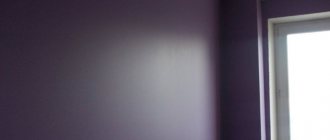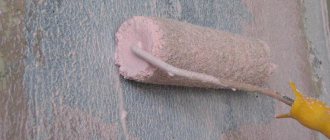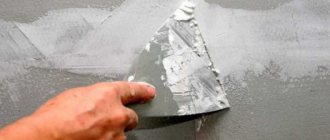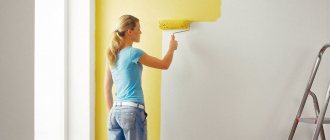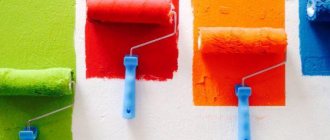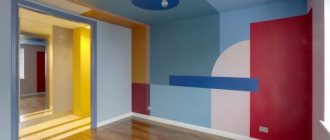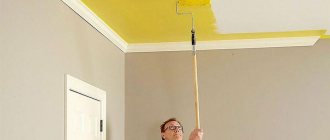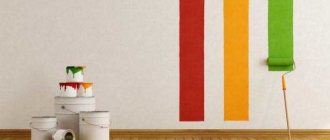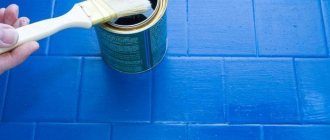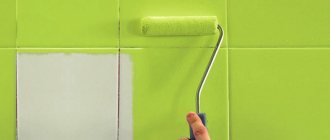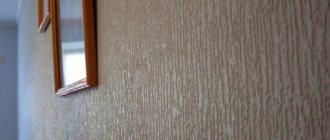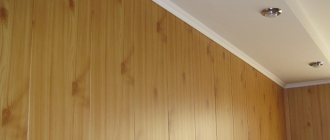The three most popular questions regarding primer are: Why do you need a primer? How to prime walls or ceiling? How long does it take for primer to dry?
Question number one most often arises when you first become acquainted with reinforcing material. Most inexperienced citizens who have started renovating an apartment simply do not know for what purpose they are treating this or that surface.
The second inevitably appears during the process of working with the primer. Not everyone knows how to properly use a brush or roller to achieve the desired effect in the shortest possible time.
Well, the third question is: “How long does it take for the primer to dry?” ” may be puzzling after its application is completed. After all, you need to continue the repairs (plaster, putty, wallpaper), but it’s not clear after what period of time.
To make the process of priming various surfaces more transparent, we have written detailed instructions for its use.
How and with what to paint plaster correctly
Plastered walls do not always require additional finishing, but if the specified layer is rough, then cladding is necessary. Painting plaster is the most common finishing method. To apply a decorative coating, the master does not require special knowledge, so all the work can be done independently.
Selection of paint for plaster
There are a large number of compositions for decorating surfaces, but not all of them have the same properties. Paint is available on plaster for interior use and for exterior use.
For interior work
To paint the walls indoors, you need to choose the appropriate composition. It must ensure the vapor permeability of the layer, its resistance to moisture, as well as any mechanical damage. Depending on the room in which the substance will be used, it may have other characteristics.
It would be good if such a finish was comfortable and easy to clean. The material should also not contain toxic substances that will be released into the environment before or after applying the product to the surface. You can choose paint for plaster for interior work among the following varieties: acrylic, water-based, latex, alkyd, oil.
For exterior decoration
Many craftsmen are interested in whether it is possible to paint plaster on the outside. This is allowed, but the selection of a suitable composition for processing is required. They must have the following properties: resistance to moisture and ultraviolet radiation, durability, wear resistance, economical consumption per 1 m2. The paint color should not fade in the sun for a long time.
Useful video
How to paint without leveling
When painting walls, a problem often arises - the unevenness of the wall violates the integrity of the coating, which subsequently leads to cracking of the paint. This misunderstanding can easily be corrected by the correct selection of building materials:
- paint roller - must be marked as a tool “for uneven walls”;
- paint - you should choose a textured one that imitates waves, strokes, wood structure, etc.
With finishing
There are three main ways to remove old finishes from a concrete surface:
- sandblasting is a hardware method that requires skill and time for subsequent drying;
- alkali solution - necessary to remove old paint;
- using a spatula is a mechanical method of scraping a layer, time-consuming, but giving an easily controlled result.
READ Floor tiles can be laid on tiles
How to paint without putty
Painting concrete without applying a layer of plaster preserves the structure of the coating visible.
We paint the plaster. We save on wall paint. Effective and cheap. Perfect walls
In interiors, concrete surfaces are used to emphasize the coldness and masculinity of the overall style of the room, therefore, as a rule, paint in shades of gray and sand is chosen.
Varieties
Correctly chosen paint for plaster will provide the desired effect for a long time. There are several types of compositions that can be used for both interior walls and facades.
Water based emulsion paint
Indoor walls are often painted using a water-based PVA-based paint. This emulsion cannot boast of a richness of shades, but the situation can be corrected with the help of coloring colors. The composition is very easy to apply, it does not contain toxic components that can be released into the environment, and it is economical. It can be used on any surface. It dries quickly.
You should not use water-based emulsion to paint surfaces in rooms with high humidity. It quickly absorbs moisture. In order for the base to be rich in color, the composition is applied in several layers. To improve the adhesion of paint to the surface, the wall is pre-primed.
Acrylic washable paint
Painting plastered walls is done with an acrylic compound if there is a high level of humidity in the room. The characteristics of the material are as follows:
If water gets on the treated walls, then this type of paint should not be used.
Silicate paint
This paint for walls on plaster contains liquid glass, fillers and natural coloring pigments. If the technology was followed when applying the substance to the surface, the layer will last at least 10-15 years. It is vapor permeable and resistant to sunlight. Fungus or mold does not form on a wall with such a coating.
The disadvantage of this material is poor adhesion to organic-based surfaces. Its elasticity is not very good, so cracks often appear on the finish. When exposed to heat, the coating may become deformed.
Silicone paint
Silicone paint is suitable for plastered walls. It is intended for facade work. The surface acquires hydrophobic properties and retains vapor permeability. A favorable indoor climate is maintained.
Alkyd and oil paint
Oil and alkyd compositions have a rich color. Once applied, they create a durable layer. But when working with them you need to use protection. The substances have a strong unpleasant odor that remains until the layer dries. The disadvantage is their high consumption and low speed of work. However, such a coating can last for a long time without requiring special care.
Is it necessary to prime the bark beetle before painting: let’s take a closer look
- Is it necessary to prime before the bark beetle?
- Compositions used
- Bark beetle priming
- What else to consider
- Summing up
Hi all! Plaster is a popular material for cladding facades and interior walls. When working with many paints and plaster materials, the surfaces are pre-primed. Is it necessary to prime the bark beetle before painting?
If you saw it, I already wrote about painting the bark beetle, and also talked about the bark beetle plaster itself.
But I practically didn’t mention the use of primers. It's time to fix the situation.
If you are ready, then I will begin. You can take something tasty, or get ready to write it down and remember it.
Is it necessary to prime before the bark beetle?
Let's look at this question in detail. Let's find out whether it is necessary to prime the bark beetle before painting, and whether it is necessary to apply the composition under the plaster itself.
During the process of facade work, many people skip the priming stage and immediately apply a layer of bark beetle.
The question is, are they making a mistake in doing so? Yes, they do. Do I need to prime before plastering? Certainly.
This is done for the following reasons:
- adhesion improves, that is, adhesion between the surface and the plaster composition;
- the service life of the finish is extended;
- the base itself is strengthened, filling pores and microcracks;
- moisture is absorbed evenly;
- the layer of finishing material dries evenly;
- acts as an antiseptic composition.
Mandatory work rules
In order for the painted wall to have a rich and rich color, the composition is applied in 2-3 layers. Each subsequent one is applied after the previous one has completely dried. In addition, it is worth considering the following rules:
If the furniture cannot be taken out of the room, then it must be protected with plastic wrap. Some types of paint are best applied when there are no drafts in the room. If the base coating technology is fully followed, the coating layer will adhere firmly and provide a good decorative function.
How many layers for the ceiling
Now the most interesting part is the required number of layers. Using fresh putty, the ceiling is painted twice, but this takes into account the layer of pre-applied primer. If there is no primer, then there will be three layers, with the first one diluted with water in a ratio of 70-80% paint and 20-30% water.
If the ceiling needs to be repainted, then there are nuances. We decided to simply renew the old paint - apply one layer of acrylic. If there was a repair, for example, cracks were filled with putty, then the places of defects are painted over point by point, after which the entire surface of the ceiling is rolled with a roller in one pass.
Caring for Painted Walls
After applying the paint, the surface must be properly cared for, which allows you to preserve the decorative properties of the material and ensure the manifestation of its technical characteristics. The coating dries completely in a few hours, but it takes up to 2 weeks to gain strength and wear resistance.
If water-based paint was used for the job, then wet cleaning of the surface is not recommended. It is better to remove dust using a dry method. Painting plaster is not a difficult task, but it is responsible. If you follow the technology, you can do all the work yourself.
Source
Is it possible to paint plaster without putty?
Leveling walls and ceilings is often done using plaster.
This construction mixture allows you to obtain a smooth surface that is highly decorative. To give the plaster a better appearance, you can apply paint to it. Painting a plaster wall is easy. But you will have to do this work very carefully. gold-plated wall paint
How to prepare for painting plaster
At the preparatory stage, the working surface must be brought into a condition suitable for work. Therefore, first the plaster layer is cleaned of dust and dirt.
Is it possible to paint plaster?
To get rid of dirt, you can use a regular damp cloth. You can clean the base thoroughly with a vacuum cleaner. When the plaster has dried, it remains to be treated with a primer. This composition will allow the paint to be more evenly distributed over the surface and better adhere to it.
Sometimes additional difficulties arise during the preparation stage. For example, unevenness may appear on the work surface. You can get rid of them if you clean the wall with fine sandpaper. It will allow you to remove even the smallest differences in height.
How to apply paint to plaster
High-quality preparation allows painting to be carried out with less labor and in a short time. The paint and varnish composition is applied to the work surface using different tools.
The easiest option is to use a roller. Since the plastered base does not have height differences, the roller will distribute the paint evenly.
But the owner must take into account that such a tool does not make the surface truly beautiful.
You can make the walls more aesthetically pleasing if you apply paint with a sponge.
It is better to use a rubber sponge. Then the effect will be especially interesting. You can also apply some kind of design to a plastered wall using a narrow brush and paint of a different color.
How to remove imperfections on the surface
The time it takes for the plaster
, may vary. But usually, after a day, nothing can harm the applied layer of paint. At this point, some defects may appear on the finish.
If the owner notices smudges or deposits, he can get rid of them using fine-grain sandpaper. Then all that remains is to brush off the dust in the place where the surface was rubbed. There is nothing complicated in the described actions.
Therefore, with a careful approach, you will definitely be able to paint a plastered wall with high quality.
Before applying the finishing touch to the walls inside an apartment, private house, office or other premises, the surfaces require preliminary preparation.
High-quality painting of plastered walls ensures the durability of the paint and varnish coating and is an effective way to create an aesthetically attractive interior.
You can order wall painting after plastering from our company by email
When decoratively painting walls, paint and varnish compositions can be applied not to smooth, but to textured and embossed plastered surfaces.
Before painting, finishers check the evenness and general condition of the walls. Painting of putty walls is carried out with the application of a deep penetration primer solution, which prevents the formation of fungus on the plastered surface and improves its adhesion to the layer of paint material.
Prices for wall putty and painting
The cost of rough finishing and painting work is calculated taking into account the total area of surfaces, their technical condition, as well as the urgency of the order.
Our employee comes to the client free of charge to see the condition of the walls, draw up a detailed cost estimate, negotiate the deadlines for completing the order and conclude an agreement on the provision of services.
You can call a specialist by phone.
Plaster painting technology
+7 or by email
You can find out prices for plastering and painting walls made of plasterboard, brick, concrete and other building materials in this section.
How to putty and paint walls
If minor defects are found on the surface, specialists perform restorative putty in separate places. Significant damage can be repaired by plastering the entire wall. After the surface has become smooth and even, you need to wait for it to dry completely and apply a starting layer of paint and varnish material.
Painting of plastered walls is carried out using:
The selected material for painting walls is applied to the prepared surface using a short-haired paint roller, a spray bottle or a narrow brush.
Painting the walls after puttying is carried out in several layers, which allows you to achieve an equally saturated color over the entire area of the treated surface.
Painting walls with a spray gun guarantees an even distribution of paint in the shortest possible time.
After puttying, walls are painted, as a rule, in two or three layers. It is imperative to use a primer as a starting layer.
Using the services of experienced finishing specialists, you can bring the interior walls into good technical condition and make the room comfortable, cozy and modern.
One of the most common and also popular methods of applying decorative coatings to the internal walls of premises and external walls of buildings is painting. Walls can be painted either directly over pre-applied plaster or over their surface. Features of painting technology will primarily be determined by the qualities of the plaster.
Materials and tools
Before you start painting, you should prepare all the necessary tools and materials.
Painting tools
How to paint plaster?
The peculiarity of plaster is that it has a texture. Therefore, painting plaster is somewhat difficult. Doing the process correctly requires patience and extreme attention to detail. However, if you paint the plaster successfully, it can last for quite a few years, and also qualitatively improve the appearance of the building.
Surface preparation
First of all, you should evaluate the current condition of the wall covering.
Painting walls as quickly and easily as possible!?
It is good if the plaster has just been applied, but if it is old, then it is recommended to carefully prepare the surface.
1. It is necessary to repair any existing cracks by covering these areas with putty. If adhesive putty is applied, it must be done with a wooden spatula. If you choose a putty based on varnish or oil, then you should use a metal tool.
2. After these measures, use a metal brush to smooth the entire surface.
3. Only after you are sure that the plaster adheres firmly to the working surface and will not fall off in the near future after painting it, you can start sanding the wall.
Step-by-step instruction
You should check the surface of the plaster, look for areas that are stained or peeling.
You can mark these areas as they will need extra attention when paint is applied to them.
The plaster can be washed using a mini-wash if the plaster is from the street. This will wash away dust and also remove loose paint left over from the previous painting. The pressure washer should be set to low pressure and a wide spray tip should be used.
Preparing walls for painting
You should choose and purchase a paint that you like. However, when choosing the best facade paint, you should pay attention to:
Tell the store clerk about your plans and ask for advice. Construction stores have a section that often displays paints intended for coating plaster. Specific paints created for painting stucco include acrylic and high-elastic primers. The seller will help you choose the most optimal paint and may even give some advice on its use.
It is best to paint plaster using a roller for the following reasons.
Painting plaster with a roller
The facade brush should be used when completing the work.
It should be used to paint areas along the edges located near doors and windows that the roller could not reach. Using a brush you can also paint over small details.
There may be deeper pores in the plaster; these should be covered with a paint brush. Also, the brush is able to reach such deep areas where the roller is powerless.
Topics of the following articles:
Features of preparation
There are several types of putties offered on the construction market; they are used for different jobs. If it is necessary to putty the concrete base, it is better to use ordinary putty. Sanding is done using a regular metal mesh, or sandpaper can be used. Not any sandpaper is suitable for this type of work; pay attention to its grain size. With smaller grains of plaster, the impact will be softer.
If you are working with a rough layer, you will need 60 grit sanding paper. If the outer surface is being processed, then No. 80 or even No. 100. After the top layer of putty has dried, prime the surface again, since putty leaves dust on it. The primer is selected taking into account the type of paint. For example, if the paint is oil-based, drying oil is required. If you add chalk to the primer, the porosity of the surface you will be painting will decrease.
When preparing the surface, it is understood that the best quality painting can be achieved by applying several layers of primer. Having completed the correct preparation of the concrete surface for painting, you can proceed to the main stage of work. You should also add some of the paint you will be using to the final coat of primer.
If you have started preparing a concrete surface for painting, then you should know some nuances. For example, it is very important if the building is new that 4 weeks have already passed since the construction of this structure. There should be a minimum amount of moisture in the concrete.
Return to contents
Is it possible to paint concrete walls without putty and plaster?
One of the ways to finish concrete walls is to paint them. Although this is not a difficult job, in order to do it correctly and efficiently, you need to adhere to the developed technologies and choose the right paint.
Paint selection
When choosing which paint to paint with, be sure to take into account the conditions in which the surface being treated will be used.
Preparing walls and ceilings for painting. Putty without stripping. Preparing walls without putty.
When purchasing paint, be sure to pay attention to its labeling . It indicates what work and surfaces it is intended for.
In the apartment
Acrylic-latex ones are suitable for use in an apartment, as they are non-toxic, resistant to temperature changes, and dry quickly.
In the garage
When choosing a material for painting walls in a garage, you need to take into account the characteristics of this room.
Paint for concrete should be: fireproof, not absorb odors, well resistant to chemicals and easy to clean.
Taking into account the peculiarities of garage operation, craftsmen here recommend using facade paints, or specialized acrylic paint for concrete floors, wear-resistant , which has all the listed characteristics.
On the street and on the balcony
To paint the outside of a building, you must use frost-resistant facade paint.
for balconies ; they have high wear resistance and protect the wall surface from the negative effects of moisture.
indoors if it is well ventilated.
Tools and materials
To perform these works, you will need the following materials:
In addition, you must have the following tools:
To paint a concrete surface, it must have normal humidity, so such work cannot be carried out earlier than a month after construction.
If you glue a film to the wall and after a day there is condensation under it, it means that the humidity of the wall is high and you need to wait until it dries.
If the wall was previously painted or insulated or covered with wallpaper, then the layer of the old coating must be removed; this can be done in several ways:
If there are protrusions , then they are knocked down using a chisel and hammer or a grinder with a diamond wheel.
To fill holes, use gypsum or cement mortar. Be sure to remove stains, rust, soot, dirt and dust. If the wall is very uneven, it will have to be plastered.
After leveling the wall, it is treated with a primer , which helps strengthen its surface. Acrylic primers or materials based on quartz sand are suitable for this.
To putty walls, a gypsum mixture is usually used, and it is applied in two layers. The first layer is for leveling rough unevenness, and the second is for final leveling the surface.
After the first layer of putty has been applied, it should dry and then be sanded with coarse sandpaper. The surface is leveled with a second layer, and after it dries, sandpaper with a larger grain size is used.
Peculiarities
Sometimes it becomes necessary to paint a concrete wall without puttingty. In such cases, it is better to use acrylic or oil paints, and the latter will be more economical.
Please note that oil compositions are less resistant to damage and precipitation than acrylic ones , so they are not recommended for outdoor use.
The procedure for painting a concrete wall will be as follows:
Useful tips
Despite the fact that there is nothing complicated in painting walls, in order to carry out this work efficiently and correctly, you must adhere to the following rules:
Conclusion
Knowing the sequence of painting a concrete wall, you can now do the work yourself. In order for the work to be done efficiently, it is necessary to prepare the surface and choose the right paint, taking into account the characteristics of the concrete surface.
How to remove old paint from a concrete wall, video:
This technology is universal: regardless of the composition with which the walls were painted and the condition of the coating, the plaster will lie smoothly and will adhere securely. But the process itself is very labor-intensive, especially when processing old walls painted with oil-based compounds.
No matter how scary and crooked it may be? And what about white paint? The owner is a gentleman.
Check the wall for the mechanical strength of the coating (separate everything that comes off mechanically), clean it from dust and dirt and paint. In this case, it doesn’t even matter what you use – a brush or a roller, since the wall will be scary in any case.
room with TV on the wall at night
Epoxy, latex or acrylic based paints are suitable for painting concrete walls.
Basics of painting various surfaces at sub-zero temperatures
Typically, painting work is planned for the warm season, when the temperature conditions are most favorable for this. The lower recommended temperature threshold for painting is plus 5 degrees. But now there are many modern paints and primers that are suitable even for negative temperatures. In this regard, the minimum possible limit at what temperature you can paint outdoors has changed.
Features of painting work in winter
In industrial conditions, the need for painting at low temperatures arises if the object needs to be delivered on time, or if there is an urgent need to renew the surface of the building. In everyday life, such urgency is rarely observed, but it still happens. There are a number of features of painting in the cold season:
- The most unfavorable temperature for using paints, enamels and primers in winter is from minus 5 degrees to plus 5 degrees. It’s better to work even in cold weather, because it is in the specified range that condensation will form on any surface. In the presence of moisture, the adhesion of the coating greatly deteriorates and the properties of the paints change. The quality of the coating decreases and it will not last long.
- If you decide to paint facades in cold weather, you need to remember that facade paint of any brand takes 2-3 times longer to dry than in warm weather. To get a high-quality coating, you need to use a heat gun for drying or stretch the film over scaffolding.
- You should choose only enamel and primer suitable for the winter season. Using the wrong material will cause it to freeze, and the ice will prevent the product from being applied to the walls. The final result of the work depends on the quality of the paint.
A number of modern paints are perfectly applied at zero temperatures and in frost, some can be used down to –20 degrees. There are good products that are resistant to temperature changes. It is important that the temperature of the paint and varnish material itself be positive during operation. If the material is cold, it is placed in a container in a bucket of warm water.
Recommendations for painting surfaces in cold weather
The rules for using primer and paint in cold air mention mandatory surface preparation. You cannot use coloring materials without certain actions:
- clean the work area from old coating;
- treat the surface with a sandblasting machine, sandpaper or other convenient method;
- fill in uneven spots with putty;
- if the technology requires, apply priming (the walls need to be primed if this is indicated by the manufacturer on the paint packaging).
You cannot work if it is raining or snowing - you need to wait for normal weather to arrive. Painting should be done with a roller or brush, but it is better to forget about the spray gun - its nozzle will quickly become clogged.
The most important thing is to make the surface clean and dry. You should also bring the enamel to the desired viscosity. Usually water-based paints are used, which are diluted with water. It is necessary to remember that alkyd materials sharply increase their viscosity in the cold, and do not forget to dilute and warm them up in time.
Primer work
In winter, use a primer that is resistant to low temperatures (frost-resistant primer). If iron is stained, special phosphating compounds are used. They can be applied over rust, as they include special anti-corrosion components. Priming provides additional protection against corrosion and increases the adhesion of the final coating.
Painting house facades
Carrying out external facade work in winter is possible if you choose the right paint. After cleaning the walls from dirt and dust, they sand them; if there are areas of old paint or mold, they are removed. Next, prime the walls with a product of the same brand as the base paint - this will improve the quality of the coating. They work with packages brought from warm places. As soon as the material begins to freeze, it is put into a warm place and another package is taken out. The second coat of paint is usually applied after 3-5 days.
Painting brick and plastered surfaces
The painting of such surfaces is no different from that of the facades of the house. It is only important not to paint immediately after finishing the masonry - the work is postponed, the minimum period is a year. If you paint right away, the coating will peel off. Surface preparation is required (cleaning with a brush to remove dirt, dust, mold). The chipped plaster is cleaned, the holes are sealed, and allowed to dry thoroughly. You can also fill deep holes with frost-resistant silicone sealant. After priming, the wall is allowed to dry for 5–7 days, then it is painted with a roller or brush.
Is it possible to paint plaster without putty – Construction and repair
Concrete walls rarely remain in their original form in the interior. External concrete elements require additional coating to avoid premature destruction. A simple and inexpensive method is painting.
Painting plastered walls: what to choose and how to apply
Painting walls is a quick and inexpensive way to give them an attractive appearance.
With a successful selection of colors and shades and perfectly evenly plastered walls, the surface will look no worse than after finishing with other types of materials.
In this article we will look at what paints are used to cover the walls after leveling them with plaster, as well as how to do the painting work yourself.
Choosing paint for plaster
To paint interior walls and decorate facades, paints of different compositions are used. After all, the requirements for them differ significantly.
For interior work
The following types of paints are most often used for painting plaster indoors:
Water-based: form a matte surface, easy to apply, economical, do not contain toxic substances, but are able to absorb moisture and quickly wash off upon contact with water, therefore they are not recommended for wet rooms.
Water-based paint can be applied to various types of surfaces: plaster, concrete, wood, brick, wallpaper, plastic elements. Available in a variety of colors and white for mixing with water-based coloring pigments. You can dilute with regular clean water. Material consumption per 1 m2 is 0.1 - 0.15 liters.
That is, one 10 liter can of paint is enough to paint approximately 80 m2 of surface in one layer. Drying time no more than 1 hour.
Tikkurila Harmony deep matte paint for walls and ceilings
Acrylic dyes are the same aqueous dispersions, but due to the higher acrylic content they provide a more durable and durable coating, which can be easily wiped with a slightly damp cloth, but excess water ingress is also unacceptable. Fits well on all types of surfaces. Consumption is slightly higher than that of water-based emulsion.
The coating can be either matte or glossy. For example, Tikkurila acrylic paint is suitable for interior work in dry rooms and with high humidity, for example, in the kitchen or bathroom, preventing wet walls from damaging the plaster. Also suitable for painting ceilings.
Material selection
When deciding what paint to paint concrete walls, you need to consider a lot of factors. First of all, they consider the main varieties, their advantages and disadvantages, compliance with the functions of the room, and cost.
When deciding how to paint a concrete wall outdoors, they give preference to synthetic and durable compounds that are not afraid of moisture, sudden temperature changes, and sunlight. But for an apartment, it is better to choose environmentally friendly paint based on natural oils or water - here external negative factors will not affect the surface, but it is very important to choose an option that is safe for health.
The purpose of the room where painting is carried out is also important. So, for the kitchen and bathroom, moisture-resistant compounds are chosen, but for the bedroom or living room, acrylic-based interior paint is also quite suitable. Moscow and the regions today offer a fairly large selection of materials on the market, so choosing the right one will not be difficult.
Oil paints
This type of composition is usually used when deciding what to paint a concrete wall on a balcony or on the street. This is the best option for outdoor work, since the paint is quite toxic and has an unpleasant odor, which then takes a long time to dissipate.
Among the disadvantages of oil compositions, it is worth mentioning the long drying time (at least a day), low level of elasticity and the risk of cracks, color instability (due to drying oil turning yellow over time).
Water based
Aqueous dispersions and emulsions are ideal for painting concrete walls in an apartment. The materials do not contain toxic elements and are often used for finishing interior surfaces. Only some types are designed specifically for covering facades, which must be indicated on the label and instructions.
The cost of the paint is relatively low - the price is an order of magnitude higher compared to oil-based compositions, but within reason.
Acrylic
This type of material is relevant for performing different types of work - paint for concrete walls is used both outside and inside. The packaging must have a mark indicating the operating conditions of the composition - covering the internal wall, facade, ceiling, etc. (Be sure to specify when choosing). Acrylic paints are often used even for European fences and for artistic wall painting.
The paints are not cheap, but they offer an ideal ratio of quality and price, which is why they are popular in the market for repair and construction materials.
Silicate
This concrete paint is made on the basis of liquid glass. The resulting coating is very durable and reliable, so the composition is often used for finishing facades.
Rubber paints are often chosen for exterior finishing. Epoxy paints are relevant for concrete floors, as they are not afraid of external influences. If you need to protect a building from destruction and fire, choose fire-resistant compounds. But textured or textured concrete paint for interior walls will be an excellent decor.
Impregnation for concrete
Before painting, it is advisable to coat the wall with a special product. A protective layer of impregnation will protect the surface from dust, moisture, and various aggressive environments. Impregnation penetrates into the very structure of the material, strengthening it. Impregnations are produced based on epoxy resins, polyurethane, acrylic, and other substances.
Paint color
When choosing a color for painting concrete, we are guided by the classical rules of design: light colors make the space visually larger and wider, dark colors make it narrower and smaller. All colors are divided into shades of the warm and cold spectrum.
There are a huge variety of options for any color - only white is presented in dozens, or even hundreds. The choice is made on the object, applying palettes to the surface and assessing the play of light, imagining the space in the imagination or modeling the room using special programs.
Is it possible to paint plaster without putty?
Some thinkers believe that the desire for beauty fundamentally distinguishes Homo sapiens from his lesser brothers. Primitive people also took care of the beauty of their own homes by painting pictures on the walls of their caves.
Contemporaries, having stepped forward intellectually and technologically, have not lost this traction to this day. One of the manifestations of such aspirations is the desire to make your home comfortable and beautiful.
And really, who would want to live in an apartment whose walls are poorly made brickwork or an unevenly cast concrete slab? The few who answer yes to this question will likely not need further information. For others, it will be useful to find out how to correct the situation and realize the genetic desire for beauty.
Methods for preparing the base
Putting the excursions aside, let's consider the methods and technologies of finishing. One of the attractive ways to decorate a room, making its design unique, is to apply decorative plaster to the walls. The following options are available:
Decorative plaster in interior design
Decorative plaster, with all its advantages, also has one drawback, common to all types. Apply it to a prepared, flat and smooth surface. The walls are brought to a suitable state in several ways:
Ordinary plaster is one of the main ways to level walls. This is explained by the low cost of the constituent materials - cement, sand, lime, and the relative ease of application. But the disadvantages of this type of finishing are also revealed. Is it worth lifting several tons of sand and cement to the 12th floor if the problems of uneven walls are solved differently?
Using drywall to prepare the base
Drywall replaces traditional plaster due to the ease of obtaining a similar, and often superior, result. LGK (as drywall is sometimes abbreviated as) has a flat plane; when properly fastened, it forms a surface suitable for further finishing.
Appearance of decorative plaster
It is necessary to putty the joining seams, which are specially thinner for this purpose, and the marks left by the heads of the screws when fastening them to profiles.
If further finishing is wallpapering, then such preparation is sufficient. If a different type of cladding is planned, or errors were made during installation, then putty is applied to the drywall.
Putty is used if the wall surface is relatively smooth and requires only minor corrections.
When performing indoor work, acrylic putty and gypsum-based composition are used. The cement mixture is used for exterior work.
Where can decorative plaster be applied?
So, the walls are prepared. The question arises: is it now possible to apply decorative plaster to them? The answer is clear - you can! Follow the usual rules for performing “decorative” work. We are talking about applying a decorative mixture to drywall.
This material is quite fragile and does not like high humidity. Although moisture-resistant drywall is produced, it is still protected from exposure to high humidity.
Decorative plaster places demands on the base for strength and non-deformability, and damp drywall does not meet either the first or second criteria.
Otherwise, the application of decorative plaster is no different for plastered and plasterboard surfaces. Thus, Venetian plaster is based on valuable stones crushed to dust, mixed with other components.
They make application easier and add a unique charm. Multiple coats are applied to achieve a look that guests are proud to show off and enjoy themselves.
After applying the base composition, Venetian plaster is protected from external influences by a finishing coating of wax.
Due to the fact that all applied layers are very thin, this type of decor does not load the base, so it is applied to drywall.
Combination of different types of decorative coatings
Application of other types of decorative plaster
Other types of decorative plasters are slightly different from Venetian. The main and critical difference is the greater thickness of the applied layer, and therefore the increasing load on the base.
Application of structural plaster
Structural plaster (“bark beetle”) is based on quartz granules of various sizes; when applied, it creates a unique appearance, somewhat reminiscent of the surface of wood eaten away by insects, for which it received its second name. This type of finishing is often used for exterior work, but it is also suitable for interior decoration.
